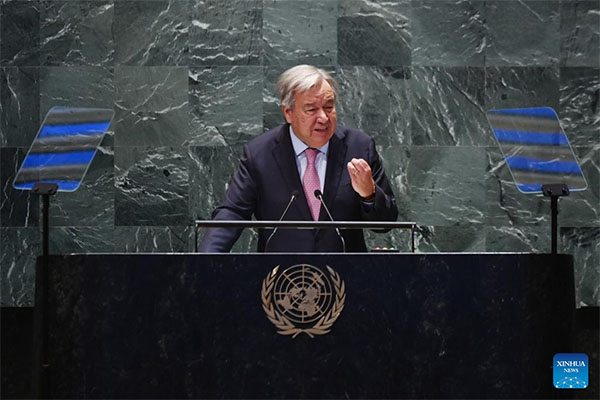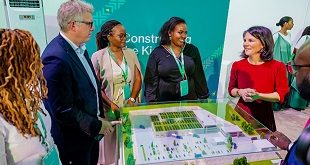
NEW YORK | Xinhua | The Summit of the Future opened at the United Nations (UN) headquarters in New York on Sunday, with the adoption of a Pact for the Future, as well as its annexes the Global Digital Compact and the Declaration on Future Generations, which cover a broad range of themes including peace and security, sustainable development, climate change, digital cooperation, human rights, gender, youth and future generations and the transformation of global governance.
The Pact for the Future is the UN’s master plan for tackling challenges that lie ahead for humanity, with 56 “actions” covering everything from peacekeeping to the potential threats posed by artificial intelligence. The pact underlines the “increasingly complex challenges” to world peace, notably the threat of nuclear war, with the document reiterating the UN’s core tenets.
The pact promises to accelerate efforts to attain the 2030 Sustainable Development Goals (SDGs), which aim for the eradication of extreme poverty by 2030, an intensified battle against hunger, promotion of gender equality and education. Most of the objectives were set in 2005, but are far from being realized. Against that backdrop, and with poor countries particularly mobilized for change, the pact especially calls for “reform of the international financial architecture.”
WHAT UNGA PRESIDENT SAYS?
“We stand at a crossroads of global transformation, facing unprecedented challenges that demand urgent, collective action,” Philemon Yang, president the UN General Assembly, said at the opening segment of the two-day summit. “From conflict and climate change to the digital divide, from inequalities to threats against human rights, together, we all face profound challenges. Yet, alongside these challenges, there is hope,” because challenges come along with opportunities.
The Pact for the Future represents the world body’s pledge not only to address immediate crises, but lay the foundations for a sustainable, just, and peaceful global order, for all peoples and nations, he said, adding that the commitments embodied in the pact and its annexes reflect the collective will of UN member states to promote international peace and security, invigorate implementation of the SDGs, foster just and inclusive societies, and ensure that technologies always serve the common good of humankind.
“The Summit of the Future is a call to action. We must shape our future to protect ourselves and our planet Earth,” said the president. “Action that recommits us to the principles of international law, the goals of the 2030 Agenda for Sustainable Development and the promise of the United Nations Charter to save future generations from the pain of war.”
The world body’s mission is to eradicate poverty in all its forms, tackle inequalities, and promote peace and security, tolerance and respect for diversity, and the summit offers a historic opportunity to ensure that progress is shared equitably across all nations and communities everywhere, he said.
“We have an obligation to harness the power of science, technology, and innovation, in order to prepare the future of humankind. It is also important that we reproduce our human successes across generations all the time,” noted the president. “Let us continue our efforts to reform and strengthen global institutions that support peace, security, sustainable development, and financial stability.”
WHAT UN SECRETARY GENERAL SAYS?
“I called for this summit to consider deep reforms to make global institutions more legitimate, fair and effective, based on the values of the UN Charter,” said UN Secretary General Antonio Guterres at the meeting. “I called for this summit because 21st century challenges require 21st century solutions: frameworks that are networked and inclusive; and that draw on the expertise of all of humanity … our world is heading off the rails — and we need tough decisions to get back on track.”
Conflicts are raging and multiplying, from the Middle East to Ukraine and Sudan, with no end in sight, he said, adding that the world’s collective security system is threatened by geopolitical divides, nuclear posturing, and the development of new weapons and theaters of war, while resources that could bring opportunities and hope are invested in death and destruction.
How I ❤️ NY! I’m here at #UNGA79 to highlight the success story of the global HIV response and to advance the fight for #OurCommonFuture! We must push for greater global solidarity if we want to meet the SDGs. ✊🏾✊🏾#SummitOfTheFuture pic.twitter.com/s9wIz7ITiO
— Winnie Byanyima (@Winnie_Byanyima) September 22, 2024
“In short, our multilateral tools and institutions are unable to respond effectively to today’s political, economic, environmental and technological challenges. And tomorrow’s will be even more difficult and even more dangerous,” noted the secretary general, stressing that things are changing fast but the world’s peace and security tools and institutions, as well as its global financial architecture, reflect a bygone era.
Technology, geopolitics and globalization have transformed power relations and the world is going through a time of turbulence and a period of transition, he addressed the meeting. With the adoption of the Pact for the Future, the Global Digital Compact and the Declaration on Future Generations, pathways are opened to new possibilities and opportunities — a breakthrough on peace and security reforms to make the Security Council more reflective of today’s world is promised.
These three landmark agreements are a step-change toward more effective, inclusive, networked multilateralism, said Guterres, noting that their implementation will prioritize dialogue and negotiation, end the wars tearing the world apart, and reform the composition and working methods of the Security Council. “To rebuild trust, we must start with the present and look to the future. People everywhere are hoping for a future of peace, dignity, and prosperity.”
WHAT SUMMIT OF THE FUTURE MEANS?
In 2020, the United Nations turned 75 and marked the occasion by starting a global conversation about hopes and fears for the future. This was the beginning of a process that would eventually lead, four years later, to the convening of the Summit of the Future, a major event this September, just before the annual high-level debate of the General Assembly.
The summit was conceived at the height of the COVID-19 pandemic, when there was a perception at the UN that countries and people pulled apart instead of cooperating to face this global threat.
“We were really confronted with the gap between the aspirations of our founders, which we were trying to celebrate at the 75th anniversary, and the reality of the world as it is today,” said Michele Griffin, the policy director of the summit.
UN member states tasked Guterres to come up with a vision for the future of global cooperation. His answer to their call was “Our Common Agenda,” a landmark report with recommendations on renewed global cooperation to address a host of risks and threats, and a proposal to hold a forward-looking summit in 2024.
The event consists of sessions and plenaries based around five main tracks — sustainable development and financing; peace and security; a digital future for all; youth and future generations; and global governance — and other topics that cut across all of the work of the UN, including human rights, gender equality and the climate crisis.
The immediate outcome is the finalized version of the Pact for the Future, with the Global Digital Compact and the Declaration for Future Generations as annexes, all of which were adopted by member states during the summit on Sunday. ■
 The Independent Uganda: You get the Truth we Pay the Price
The Independent Uganda: You get the Truth we Pay the Price



